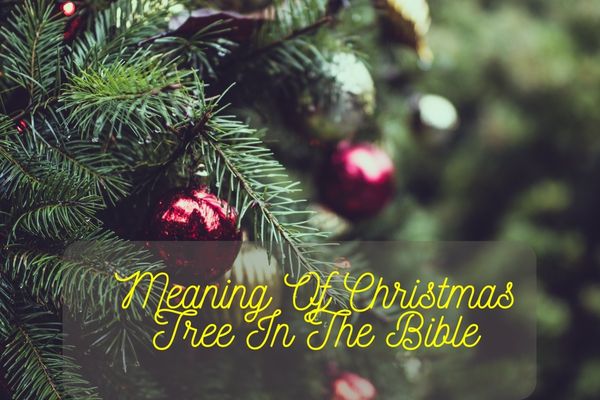Table of Contents Show
Meaning Of Christmas Tree In The Bible? Explore the profound symbolism of the Christmas tree in the Bible, unraveling the rich shade of traditions that connect this cherished holiday symbol to ancient scriptures.
Journey through the pages of history as we look into the roots of the Christmas tree’s significance, discovering the spiritual narratives that have shaped its presence in festive celebrations.
Uncover the hidden layers of meaning that intertwine the evergreen beauty with timeless biblical messages, illuminating the true essence of Christmas.
Meaning Of Christmas Tree In The Bible
The Bible does not specifically mention Christmas trees, as the modern celebration of Christmas with decorated trees is a tradition that developed much later in history. The use of evergreen trees in winter celebrations predates Christianity and has roots in various cultures.
The tradition of decorating trees during the Christmas season became popular in the 16th century in Germany. It is often associated with Martin Luther, who, according to legend, was inspired by the beauty of the stars shining through the evergreen trees and brought a tree into his home with candles to replicate the effect. Over time, this practice spread and evolved into the Christmas tree tradition as we know it today.
In a biblical context, some argue that certain passages indirectly mention trees or tree-related symbolism that can be loosely connected to Christmas trees. For example, in the Old Testament, the book of Jeremiah 10:1-5 (ESV) contains a passage cautioning against the practices of the nations, which includes cutting down and decorating trees:
“Hear the word that the Lord speaks to you, O house of Israel. Thus says the Lord: ‘Learn not the way of the nations, nor be dismayed at the signs of the heavens because the nations are dismayed at them, for the customs of the peoples are vanity. A tree from the forest is cut down and worked with an axe by the hands of a craftsman. They decorate it with silver and gold; they fasten it with hammer and nails so that it cannot move.'”
It’s important to note that interpretations of this passage vary, and not all scholars or religious authorities agree on a direct connection between these verses and the modern Christmas tree tradition. Christmas trees are primarily a cultural and historical tradition that has evolved, rather than a practice rooted directly in biblical teachings.
Significance of the Christmas Tree In The Bible
The Christmas tree, as it is commonly known today, does not have a direct biblical origin. However, some people draw symbolic connections between certain elements of the Christmas tree and biblical themes. It’s important to note that the use of Christmas trees in celebrating the holiday has evolved and is more rooted in cultural and historical traditions than direct biblical teachings. Here are a few interpretations that some people associate with the Christmas tree about the Bible:
Evergreen Symbolism
The evergreen nature of the Christmas tree is sometimes seen as a symbol of eternal life. This idea is based on the fact that evergreen trees retain their green leaves throughout the year, even in winter, representing the hope of everlasting life.
Tree of Life
Some individuals draw parallels between the Christmas tree and the biblical concept of the “Tree of Life.” In the Bible, the Tree of Life is mentioned in the Garden of Eden in the book of Genesis. It is associated with eternal life and the presence of God.
Decorations and Lights
The tradition of decorating Christmas trees with ornaments and lights is sometimes seen as a way to symbolize the light of Christ. In Christian theology, Jesus is often referred to as the “Light of the World.” The lights on the tree may represent the spiritual light that Jesus brings into the world.
It’s essential to recognize that these interpretations are not universally accepted, and the use of Christmas trees in celebrating the holiday varies among Christian denominations and cultures. The practice of decorating trees during the Christmas season has more to do with cultural and historical traditions than direct biblical commandments. Christians celebrate Christmas as the birth of Jesus Christ, and the use of Christmas trees is a cultural and festive tradition that has evolved over centuries.
Conclusion
As we conclude our exploration of the Christmas tree in the Bible, the radiant connections between faith, tradition, and celebration become clearer. From the symbolic branches to the twinkling lights, each element resonates with spiritual significance, echoing messages of hope, renewal, and everlasting life. Embrace the festive season with a renewed understanding of the Christmas tree’s profound roots in biblical narratives, fostering a deeper connection to the timeless stories that continue to inspire joy and goodwill.
FAQ
1. What is the origin of the Christmas tree tradition?
The Christmas tree tradition is believed to have originated in Germany in the 16th century. Its association with Christmas grew over time, with the evergreen tree symbolizing eternal life and the lights representing the light of Christ. The tradition was popularized by Queen Victoria and Prince Albert in England during the 19th century.
2. Why do we exchange gifts during Christmas?
The tradition of exchanging gifts during Christmas is rooted in the biblical story of the Three Wise Men presenting gifts to the infant Jesus.








